新编实用英语综合教程1第 7单元教案
- 格式:pdf
- 大小:248.38 KB
- 文档页数:10
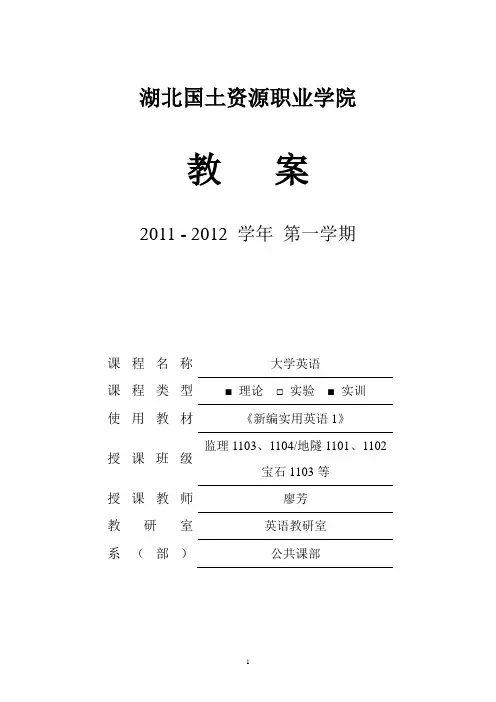
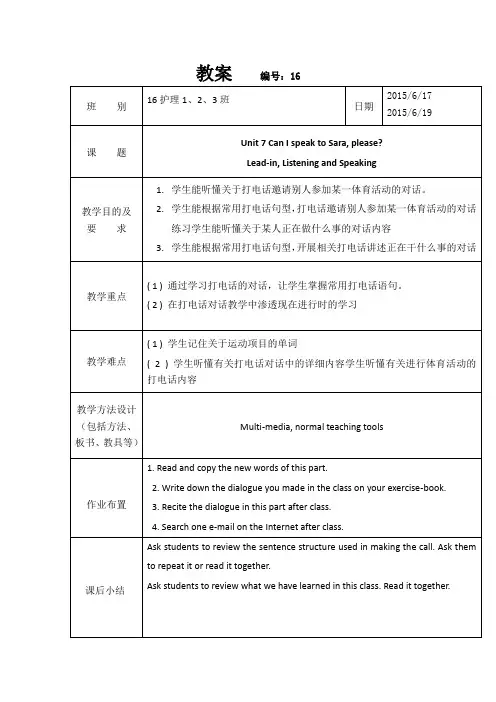
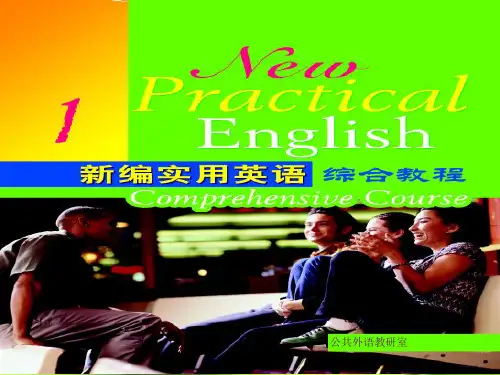
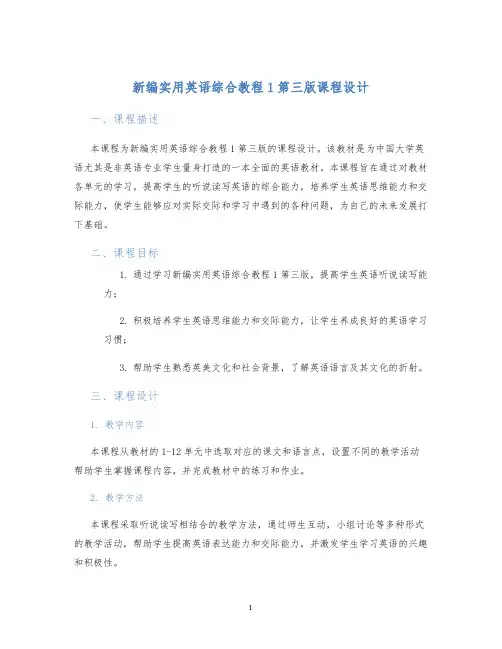
新编实用英语综合教程1第三版课程设计一、课程描述本课程为新编实用英语综合教程1第三版的课程设计。
该教材是为中国大学英语尤其是非英语专业学生量身打造的一本全面的英语教材。
本课程旨在通过对教材各单元的学习,提高学生的听说读写英语的综合能力,培养学生英语思维能力和交际能力,使学生能够应对实际交际和学习中遇到的各种问题,为自己的未来发展打下基础。
二、课程目标1.通过学习新编实用英语综合教程1第三版,提高学生英语听说读写能力;2.积极培养学生英语思维能力和交际能力,让学生养成良好的英语学习习惯;3.帮助学生熟悉英美文化和社会背景,了解英语语言及其文化的折射。
三、课程设计1. 教学内容本课程从教材的1-12单元中选取对应的课文和语言点,设置不同的教学活动帮助学生掌握课程内容,并完成教材中的练习和作业。
2. 教学方法本课程采取听说读写相结合的教学方法,通过师生互动,小组讨论等多种形式的教学活动,帮助学生提高英语表达能力和交际能力,并激发学生学习英语的兴趣和积极性。
3. 课程安排本课程全程共分为12个单元,每个单元大致按以下内容进行:•听力材料的听写、训练及模仿•语音语调的训练•阅读理解,扩充词汇,分析语法•词汇拓展及句型运用•与话题相关的口语题目讨论及练习•与话题相关的书面表达练习•与话题相关的文化背景知识的介绍和讲解4. 课程评估考核方案包括练习与作业开发、互动课堂参与度、期初、期中考核和期末考核。
四、教学成果本课程的主要教学成果是让学生在听、说、读、写四个方面全面提高,掌握基本英语语言技能和交际能力,具备熟练运用英语的能力,达到独立学习和交流的水平。
同时,学生还将对英美文化,历史和社会的了解更加深入。
五、总结本课程的设计旨在提供多角度、多形式的教学活动,以达到全面提高学生英语综合能力的目的。
广泛地引用了跨文化交际、情景教学和主题式教学等方法,更好地激活学生参与到英语学习中来。
考虑到不同学生的学习需求,本课程更加注重课程的灵活性和个性化的教学方式,从而使学生更好地实现本课程的目标。
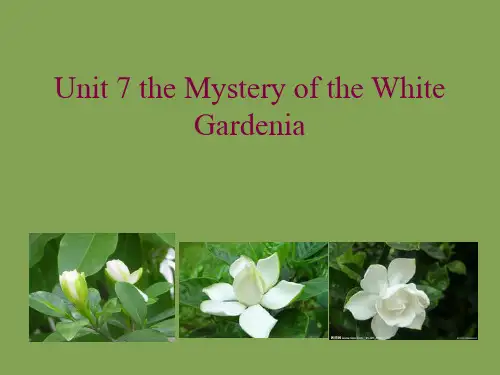
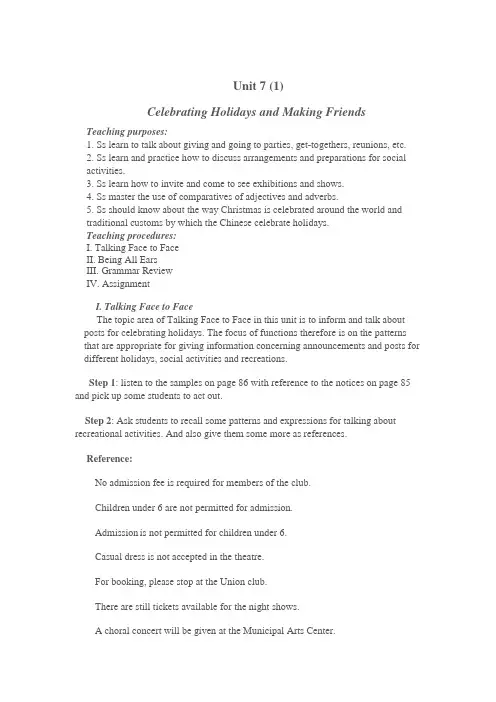
Unit 7 (1)Celebrating Holidays and Making Friends Teaching purposes:1. Ss learn to talk about giving and going to parties, get-togethers, reunions, etc.2. Ss learn and practice how to discuss arrangements and preparations for socialactivities.3. Ss learn how to invite and come to see exhibitions and shows.4. Ss master the use of comparatives of adjectives and adverbs.5. Ss should know about the way Christmas is celebrated around the world andtraditional customs by which the Chinese celebrate holidays.Teaching procedures:I. Talking Face to FaceII. Being All EarsIII. Grammar ReviewIV. AssignmentI. Talking Face to FaceThe topic area of Talking Face to Face in this unit is to inform and talk about posts for celebrating holidays. The focus of functions therefore is on the patterns that are appropriate for giving information concerning announcements and posts for different holidays, social activities and recreations.Step 1: listen to the samples on page 86 with reference to the notices on page 85 and pick up some students to act out.Step 2: Ask students to recall some patterns and expressions for talking about recreational activities. And also give them some more as references.Reference:No admission fee is required for members of the club.Children under 6 are not permitted for admission.Admission is not permitted for children under 6.Casual dress is not accepted in the theatre.For booking, please stop at the Union club.There are still tickets available for the night shows.A choral concert will be given at the Municipal Arts Center.This Weeks Film: Tiny TimesIn case of rain, the runway show will take place in the gym.Buses are available and leave at 6:00 p.m. from the Days Hotel.Here comes a rare chance to appreciate the trio Tenors!The super star Super Junior will lead the performance.Step 3: Make dialogues according to the examples on page 87 and act out.II. Being All Ears1.Listen to Dialogue 1 and decode the message by finding the correct choices inthe blanks.2.Listen to Dialogue 2 and complete the statements.3.Listen to the dialogue again and do the multiple choice exercise.4.Do some listening exercises about PRECTOIII. Grammar1.“as+adj/adv+as或not so(as)+adj/adv+as.”句型。
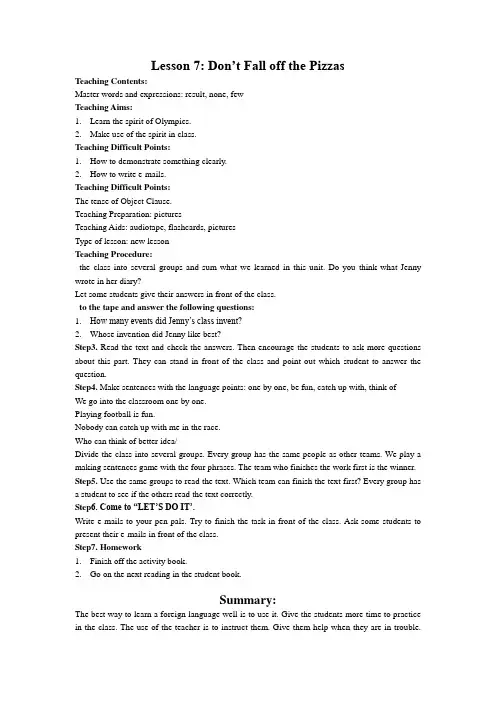
Lesson 7: Don’t Fall off the PizzasTeaching Contents:Master words and expressions: result, none, fewTeaching Aims:1.Learn the spirit of Olympics.2.Make use of the spirit in class.Teaching Difficult Points:1.How to demonstrate something clearly.2.How to write e-mails.Teaching Difficult Points:The tense of Object Clause.Teaching Preparation: picturesTeaching Aids: audiotape, flashcards, picturesType of lesson: new lessonTeaching Procedure:the class into several groups and sum what we learned in this unit. Do you think what Jenny wrote in her diary?Let some students give their answers in front of the class.to the tape and answer the following questions:1.How many events did Jenny’s class invent?2.Whose invention did Jenny like best?Step3. Read the text and check the answers. Then encourage the students to ask more questions about this part. They can stand in front of the class and point out which student to answer the question.Step4. Make sentences with the language points: one by one, be fun, catch up with, think ofWe go into the classroom one by one.Playing football is fun.Nobody can catch up with me in the race.Who can think of better idea/Divide the class into several groups. Every group has the same people as other teams. We play a making sentences game with the four phrases. The team who finishes the work first is the winner. Step5. Use the same groups to read the text. Which team can finish the text first? Every group has a student to see if the others read the text correctly.Step6. Come to “LET’S DO IT’.Write e-mails to your pen pals. Try to finish the task in front of the class. Ask some students to present their e-mails in front of the class.Step7. Homework1.Finish off the activity book.2.Go on the next reading in the student book.Summary:The best way to learn a foreign language well is to use it. Give the students more time to practice in the class. The use of the teacher is to instruct them. Give them help when they are in trouble.Class is a large stage for the students to act.。
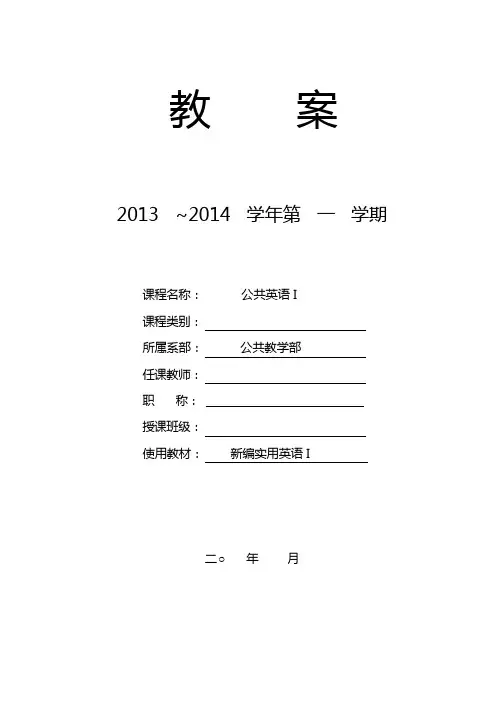
教案2013 ~2014 学年第一学期课程名称:公共英语 I课程类别:所属系部:公共教学部任课教师:职称:授课班级:使用教材:新编实用英语 I二○年月章节或项目名称授课类型理论实验实训其它√□□□教学目标 (知识目标/能力目标)重点与难点教学方法与手段Unit 1- Section 1 Talking face to face- Section 2 Being all ears授课进度符合√超前□滞后□停补□班级建筑1321装饰1321地点教B205教B207周次第 6 周第 6 周星期五五节次5-67-81. Greeting people and giving responses;2. Saying good-bye to people;3. Exchanging personal information;4. Introducing people to each other.1. Greeting people and giving responses: first meeting and meeting again;2. Communicating personal information;3. Introducing people to each other;4. Key words and expressions.Teaching and role play教学过程(教学环节、各环节要点、时间分配等) 1. New words and expressions 10min2. Talking face to face 20min3. Practice the dialogues 10minBeing All Ears Review节S tudents have learned how to greet people and give responses, and exchange personal informations1. Make up dialogues for greeting and introducing people referring to the dialogues in the Workbook.2. Do the Put-in-use exercises.3. Preview Passage I and the exercises.第一节第二教学 小结作业 布置35min 5min章节或项目名称授课类型理论实验实训其它√□□□教学目标 (知识目标/能力目标) Unit 1- Section 3 Maintain a Sharp EyePassage I授课进度符合√超前□滞后□停补□班级建筑1321装饰1321地点教B205教B207周次第 7 周星期一一节次7-85-6第 7 周and British people greet each 5. How Americanother;6. Key words and expressions.5. How American and British people greet each other;6. Key words and expressions;7. Translate the Chinese sentences into English. Teaching and role play教学方法与手段教学过程(教学环节、各环节要点、时间分配等)重点与难点1. Review the useful expressions about 5minhow to greet people and give responses;第一2. The way Americans greet;3. Useful words and expressions.20min15min节第二1. Reading of the passage;2. Do and explain the exercises.3. Review10min25min5 min节教学小结作业布置Students have learned the way how American and British people greet each other.4. Learn by heart of Passage I;5. Preview Passage II and the exercises.章节或项目名称 Unit 1- Section 3 Maintain a Sharp EyePassage II授课类型理论实验实训其它√□□□教学目标 (知识目标/能力目标) 授课进度符合√超前□滞后□停补□班级建筑1321装饰1321地点教B205教B207周次第 7 周第 7 周星期五五7. Self-introduction;8.Description of a person’s appearance;9. Key words and expressions.节次5-67-8重点与难点8. Key words and expressions.9.Description of a person’s appearance;10. Self-introduction.Teaching and practicing教学方法与手段教学过程(教学环节、各环节要点、时间分配等)第一节第二1. Review useful words and expressions;2. A little about me;3. Useful words and expressions.1. Read aloud of the passage;2. Do and explain the exercises;3. Rewrite the story in the third person;4. Review10min20min10min5min20min10min5min节教学小结作业布置Students have learned how to introduce themselves and depicta person’s appearance.6. Review what we have learned;7. Preview and do the exercises in Trying your hand and Grammar.章节或项目名称 Unit 1- Section 4 Trying your hand and grammar 授课类型理论实验实训其它√□□□授课进度符合√超前□滞后□停补□班级建筑1321装饰1321地点教B205教B207周次第 8 周第 8 周星期一一节次7-85-61. Writing a business card;教学目标 (知识 2. Basic sentence structure; 目标/能力目标)重点与难点1. Writing a business card;2. Basic sentence structure; Teaching and practicing教学方法与手段教学过程(教学环节、各环节要点、时间分配等)教学小结作业布置1. Review the useful expressions about 10minhow to introduce oneselves and depict aperson’s appearance;2. Translate business cards; 15min3. Ask students to write a business card of 15minthemselves.1. Sentence writing and grammar review; 20min2. Do and explain the exercises; 15min3. Review. 5min1. Students have learned how to write a business card ;2. Basic sentence structure.1. Review what we have learned;2. Remember the new words and impressions;3. Do the exercises in the workbook;4. Preview Unit 2.第一节第二节章节或项目名称Unit 2- Section 1 Talking face to face- Section 2 Being all ears 授课类型理论实验实训其它√□□□教学目标 (知识目标/能力目标) 授课进度符合√超前□滞后□停补□班级建筑1321装饰1321地点教B205教B207周次第8 周第8 周星期五五节次5-67-81. Expressing pleasure and thanks on receiving agift;2. Congratulating and responding;3. Expressing regrets and asking for forgiveness;1. Congratulating and responding;2. Expressing regrets and asking for forgiveness;3. Key words and expressions.Teaching and role play教学方法与手段重点与难点教学过程(教学环节、各环节要点、时间分配等)10min第一1. New words and expressions2. Talking face to face3. Practice the dialogues20min10min节1. Being All Ears 35min 第2. Review 5min教学小结作业布置Students have learned the useful expressions of expressing pleasure and thanks on receiving a gift and expressing regrets and asking for forgiveness.1. Make up dialogues for giving and replying to a gift;2. Do the Put-in-use exercises.3. Preview Passage I and the exercises.二节章节或项目名称 Unit 2- Section 3 Maintain a Sharp EyePassage I授课类型理论 实验 实训 其它 √ □ □□教学目标 (知识 授课进度 班级 地点 周次 星期 节次 符合 √ 建筑 教 1321 B205超前 □滞后 □ 装饰 教 1321 B207停补 □1. Gift culture ;2. Culture differences in expressing friendship ; 目标/能力目标)3. Key words and expressions.重点与难点1. Culture differences in expressing friendship;2. Key words and expressions;3. Translate the Chinese sentences into English.Teaching and practising教学方法 与手段教学过程(教学环节、各环节要点、时间分配等)第 9 周 一 5-6第 9 周 一 7-81. Review the useful expressions about 5minhow to reply to a gift card;第一2. Different attitudes towards gift-giving;3. Useful words and expressions.20min15min节第1. Read aloud the passage;2. Do and explain the exercises.3. Review10min25min5 min教学小结作业布置Students have learned the two different attitudes towards gift-giving.1. Learn by heart of Passage I;2. Preview Passage II and the exercises.二节章节或项目名称Unit 2- Section 3 Maintain a Sharp EyePassage II授课类型理论实验实训其它√□□□授课进度符合√超前□滞后□停补□1. How to班级建筑1321装饰1321地点教B205教B207周次第10周第10周write a thank-you note;星期一一节次7-85-6教学目标 (知识目标/能力目标) 2. Gift culture;3. Key words and expressions.重点与难点1. Key words and expressions.2. How to write a thank-you note;3. Self-introduction.Teaching and practicing教学方法与手段教学过程(教学环节、各环节要点、时间分配等)1. Review useful words and expressions; 10min2. Thank- you notes are heart-warming; 20min 第3. Useful words and expressions. 10min一节1. Read aloud of the passage; 5min2. Do and explain the exercises; 20min 第3. Retell the last two paragraphs without 10min looking at the book;二 4. Review 5min 节教学小结作业布置Students have learned how to write a thank-you note.1. Review what we have learned;2. Preview and do the exercises in Trying your hand andGrammar.章节或项目名称授课类型理论 实验 实训 其它 √ □ □□教学目标 (知识 目标/能力目标)Unit 2- Section 4 Trying your hand and grammar授课进度 班级 地点 周次 星期 节次 符合 √ 建筑 教 第 101321 B205 周超前 □滞后 □ 装饰 教 第 101321 B207 周停补 □1. Writing and replying to a thank-you note,acongratulation letter and a letter of apology ; 2. Use of articles:a,an,the;1. Writing and replying to a thank-you note,acongratulation letter and a letter of apology ; 2. Use of articles:a,an,the;Teaching and practicing教学方法 与手段教学过程(教学环节、各环节要点、时间分配等)重点与难点五 5-6五 7-8教学小结作业布置1. Review the words and expressions; 10min2. Translate thank-you note, acongratulation letter and a letter of 15minapology;3. Ask students to write congratulation 15minletter.1. Sentence writing and grammar review; 20min2. Do and explain the exercises; 15min3. Review. 5minStudents have learned how to write a congratulation letter and how to use of articles:a,an,the.1. Review what we have learned;2. Remember the new words and impressions;3. Do the exercises in the workbook;4. Preview Unit 3.第一节第二节章节或项目名称 Unit 3- Section 1 Talking face to face- Section 2 Being all ears 授课类型理论实验实训其它√□□□授课进度符合√超前□滞后□停补□1. Asking班级建筑1321装饰1321地点教B205教B207周次第 11周第 11周星期一一where a particular place is ;节次7-85-6教学目标 (知识 2. Showing derections; 目标/能力目标)重点与难点1. Asking where a particular place is ;2. Showing derections;3. Key words and expressions. Teaching and practicing教学方法与手段教学过程(教学环节、各环节要点、时间分配等)1. New words and expressions 10min2. Talking face to face 20min 第3. Practice the dialogues 10min一节1. Being All Ears 35min2. Review. 5min 第二节教学小结作业布置Students have learned how to ask where a particular place is and show directions.1. Review what we have learned;2. Remember the new words and impressions;3. Do the Put-in-use exercises.4. Preview Passage I and the exercises.章节或项目名称 Unit 3- Section 3 Maintain a Sharp EyePassage I授课类型理论实验实训其它√□□□授课进度符合√超前□滞后□停补□1. Different班级建筑1321装饰1321地点教B205教B207周次第 11周第 11周星期五五feelings about traveling ;节次5-67-8教学目标 (知识 2. Key words and expressions. 目标/能力目标)重点与难点1. Different feelings about traveling ;2. Key words and expressions.3. Translate the Chinese sentences into English. Teaching and practising教学方法与手段教学过程(教学环节、各环节要点、时间分配等)1. Review the useful expressions about 5minhow to ask where a particular place is第and show directions.;2. I hate flying; 20min一 3. Useful words and expressions. 15min 节1. Read aloud the passage; 10min2. Do and explain the exercises. 25min 第3. Review 5 min教学小结作业布置Students have learned the different feelings about traveling and useful expressions.3. Learn by heart of Passage I;4. Preview Passage II and the exercises.二节章节或项目名称 Unit 3- Section 3 Maintain a Sharp EyePassage II授课类型理论实验实训其它√□□□授课进度符合√超前□滞后□停补□1.I’d been班级建筑1321装饰1321地点教B205教B207周次第 12周第 12周星期一一treated like a friend in need;节次7-85-6教学目标 (知识目标/能力目标) 2. different feelings about traveling;3. Key words and expressions.重点与难点1. I’d been treated like a friend in nee d;2. different feelings about traveling;3. Key words and expressions. Teaching and practicing教学方法与手段教学过程(教学环节、各环节要点、时间分配等)1. Review useful words and expressions; 10min2. I’d been treated like a friend in need ; 20min 第3. Useful words and expressions. 10min一节5. Read aloud of the passage; 5min6. Do and explain the exercises; 20min 第7. Retell the last two paragraphs without 10min looking at the book;二 8. Review 5min 节教学小结作业布置Students have learned the different feelings about traveling and useful expressions.3. Review what we have learned;4. Preview and do the exercises in Trying your hand andGrammar.章节或项目名称授课类型理论实验实训其它√□□□教学目标 (知识目标/能力目标) Unit 3- Section 4 Trying your hand and grammar授课进度符合√超前□滞后□停补□班级建筑1321装饰1321地点教B205教B207周次第 12周第 12周星期五五节次5-67-81. Understanding and writing of road and officesigns ;2. Forming of plural nouns;1. Understanding and writing of road and officesigns ;2. Forming of plural nouns;Teaching and practicing教学方法与手段教学过程(教学环节、各环节要点、时间分配等)重点与难点教学小结作业布置1. Review the words and expressions; 10min2. Translate the guiding direction of acompany and the shopper’s guide of a15minshopping mall ;3. Do and explain the exercises. 15min1. Sentence writing and grammar review; 20min2. Do and explain the exercises; 15min3. Review. 5minStudents have learned how to write a congratulation letter and how to use of articles:a,an,the.1. Review what we have learned;2. Remember the new words and impressions;3. Do the exercises in the workbook;4. Preview Unit 4.第一节第二节章节或项目名称Unit4- Section 1 Talking face to face- Section 2 Being all ears 授课类型理论实验实训其它√□□□教学目标 (知识目标/能力目标) 授课进度符合√超前□滞后□停补□班级建筑1321装饰1321地点教B205教B207周次第13周第13周星期一一节次7-85-61. Making/keeping/postponing/putting off anappointment according to a work timetable;2. Making reservations according to a timetable offlights and trains;1. Making/keeping/postponing/putting off anappointment according to a work timetable;2. Making reservations according to a timetable offlights and trains;3. Key words and expressions.Teaching and role play教学方法与手段重点与难点教学过程(教学环节、各环节要点、时间分配等)第一节第1. New words and expressions2. Talking face to face3. Practice the dialogues3. Being All Ears4. Review10min20min10min35min5min教学小结作业布置Students have learned the useful expressions of making reservations according to a timetable of flights and trains.1. Make up dialogues for making an appointment according toa work timetable;2. Do the Put-in-use exercises.3. Preview Passage I and the exercises.二节章节或项目名称授课类型理论实验实训其它√□□□教学目标 (知识目标/能力目标) Unit 4- Section 3 Maintain a Sharp EyePassage I授课进度符合√超前□滞后□停补□班级建筑1321装饰1321地点教B205教B207周次第13周第13周星期五五节次5-67-81. Punctuality and keeping promises in socialactivities;2. Key words and expressions.1. Punctuality and keeping promises in socialactivities;2. Key words and expressions.Teaching and practising教学方法与手段教学过程(教学环节、各环节要点、时间分配等)重点与难点1. Review the useful expressions about 5minhow to make reservations according to a第timetable of flights and trains; 20min2. Punctuality and keeping promises in 15min 一social activities;3. Useful words and expressions.节第1. Read aloud the passage;2. Do and explain the exercises.3. Review10min25min5 min教学小结作业布置Students have learned that it is important to be punctual, to have a strong conception of time in social activities.1. Learn by heart of Passage I;2. Preview Passage II and the exercises.二节章节或项目名称Unit 4- Section 3 Maintain a Sharp EyePassage II授课类型理论实验实训其它√□□□授课进度符合√超前□滞后□停补□1. Methods班级建筑1321装饰1321地点教B205教B207周次第14周第14周of organizing time星期一一节次7-85-6教学目标 (知识2. Key words and expressions. 目标/能力目标)重点与难点1. Methods of organizing time2. Key words and expressions .Teaching and practicing教学方法与手段教学过程(教学环节、各环节要点、时间分配等)第一3. Review useful words and expressions; 10min4. Begin each day with a fresh plan of 20minattack; 10min 5. Read aloud of the passage.节1. Students choose some expressions and 5minsentences from the passage;第二2. Useful words and expressions.3. Do and explain the exercises;4. Review10min20min5min节教学小结作业布置Students have learned the methods of organizing time.1. Review what we have learned;2. Preview and do the exercises in Trying your hand andGrammar.章节或项目名称 Unit4- Section 4 Trying your hand and grammar 授课类型理论实验实训其它√□□□授课进度符合√超前□滞后□停补□班级建筑1321装饰1321地点教B205教B207周次第 14周第 14周星期五五节次5-67-81. Writing a timetable and a schedule;教学目标 (知识 2. Use of verb tenses.目标/能力目标)Use of verb tenses.重点与难点Teaching and practicing教学方法与手段教学过程(教学环节、各环节要点、时间分配等)教学小结作业布置1. Review the words and expressions; 10min2. Ask students to write a timetable and aschedule. 15min15min1. Sentence writing and grammar review; 20min2. Do and explain the exercises; 15min3. Review. 5minStudents have learned how to write a schedule and how to use the verb tenses.1. Review what we have learned;2. Remember the new words and impressions;3. Do the exercises in the workbook;4. Preview Unit5.第一节第二节章节或项目名称 Unit5- Section 1 Talking face to face- Section 2 Being all ears 授课类型理论实验实训其它√□□□教学目标 (知识目标/能力目标)重点与难点授课进度符合√超前□滞后□停补□班级建筑1321装饰1321地点教B205教B207周次第 15周第 15周星期一一节次7-85-61. Understanding the forecast of global or localweather conditions;2. Talking about weather changes.3. Key words and expressions.1. Talking about weather changes.2. Talking about the weather to start a conversation.3. Key words and expressions.Teaching and role play教学方法与手段教学过程(教学环节、各环节要点、时间分配等)第4. New words and expressions5. Talking face to face6. Practice the dialogues10min20min10min 5. Being All Ears 35min第 6. Review 5min教学小结作业布置Students have learned the useful expressions of talking aboutmaking comments on weather conditions.4. Make up dialogues for talkingconditions ;5. Do the Put-in-use exercises.6. Preview Passage I and the exercises.the weather to start a conversation andabout the weather一节二节章节或项目名称 Unit 5- Section 3 Maintain a Sharp EyePassage I授课类型理论实验实训其它√□□□授课进度符合√超前□滞后□停补□班级建筑1321装饰1321地点教B205教B207周次第 15周第 15周星期五五节次5-67-81. Weather report for different places;教学目标 (知识 2. Key words and expressions. 目标/能力目标)重点与难点1. Weather report for different places;2. Key words and expressions. Teaching and practising教学方法与手段教学过程(教学环节、各环节要点、时间分配等)4. Review the key words and useful 5minexpressions第一5. Is it going to be a fine day;6. Useful words and expressions.20min15min节第4. Read aloud the passage;5. Do and explain the exercises.6. Review10min25min5 min教学小结作业布置Students have learned weather report for differentthe useful expressions.1. Learn by heart of Passage I;2. Preview Passage II and the exercises.places and二节章节或项目名称 Unit 5- Section 3 Maintain a Sharp EyePassage II授课类型理论实验实训其它√□□□授课进度符合√超前□滞后□停补□班级建筑1321装饰1321地点教B205教B207周次第 16周第 16周星期一一节次7-85-61. British people ’s habits :talking about the weather教学目标 (知识目标/能力目标)to start a conversation.2. Key words and expressions1. British people’s habits :talking about the weatherto start a conversation.2. Key words and expressionsTeaching and practicing教学方法与手段教学过程(教学环节、各环节要点、时间分配等)重点与难点6. Review useful words and expressions; 10min7. British people like talking about the 20min 第 weather; 10min8. Read aloud of the passage.一节5. Students choose some expressions and 5minsentences from the passage;第二6. Useful words and expressions.7. Do and explain the exercises;8. Review10min20min5min节教学小结作业布置Students have learned the British people’s habits of talking about the weather to start a conversation.3. Review what we have learned;4. Preview and do the exercises in Trying your hand andGrammar.章节或项目名称 Unit5- Section 4 Trying your hand and grammar 授课类型理论实验实训其它√□□□教学目标 (知识目标/能力目标)重点与难点授课进度符合√超前□滞后□停补□班级建筑1321装饰1321地点教B205教B207周次第 16周第 16周星期五五节次5-67-8 Teaching and practicing教学方法与手段教学过程(教学环节、各环节要点、时间分配等)4. Review the words and expressions; 10min5. Translate thank-you note, a第congratulation letter and a letter of 15min apology;一 6. Ask students to write congratulation 15minletter.节第4. Sentence writing and grammar review;5. Do and explain the exercises;6. Review.20min15min5min教学小结作业布置Students have learned how to write a congratulation letter and how to use of articles:a,an,the.8. Review what we have learned;9. Remember the new words and impressions;10. Do the exercises in the workbook;11. Preview Unit 6.二节。
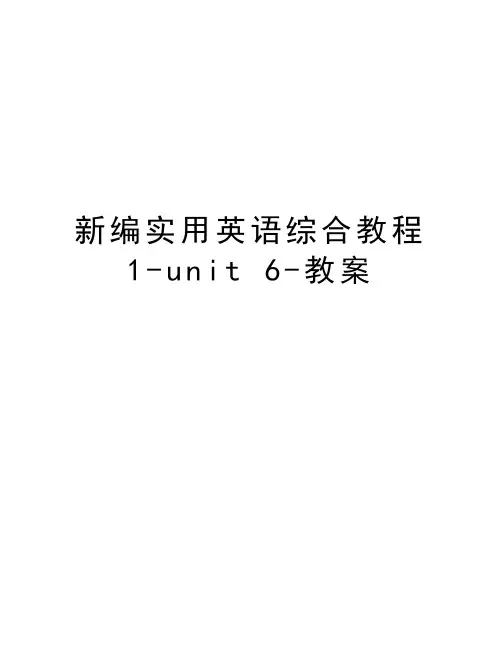
新编实用英语综合教程1-u n i t6-教案
用心整理的精品word文档,下载即可编辑!!
教案首页
精心整理,用心做精品1
用心整理的精品word文档,下载即可编辑!!
课堂组织
教案内容
精心整理,用心做精品2
用心整理的精品word文档,下载即可编辑!!
精心整理,用心做精品3
用心整理的精品word文档,下载即可编辑!!
精心整理,用心做精品4
用心整理的精品word文档,下载即可编辑!!
教案首页
精心整理,用心做精品5
用心整理的精品word文档,下载即可编辑!!
课堂组织
精心整理,用心做精品6
用心整理的精品word文档,下载即可编辑!!
教案内容
精心整理,用心做精品7
用心整理的精品word文档,下载即可编辑!!
精心整理,用心做精品8
用心整理的精品word文档,下载即可编辑!!
精心整理,用心做精品9
教案首页
课堂组织
教案内容
教案首页
课堂组织
教案内容。
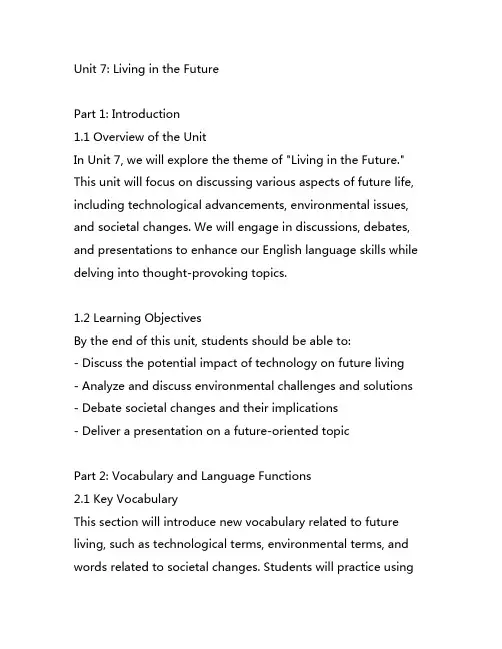
Unit 7: Living in the FuturePart 1: Introduction1.1 Overview of the UnitIn Unit 7, we will explore the theme of "Living in the Future." This unit will focus on discussing various aspects of future life, including technological advancements, environmental issues, and societal changes. We will engage in discussions, debates, and presentations to enhance our English language skills while delving into thought-provoking topics.1.2 Learning ObjectivesBy the end of this unit, students should be able to:- Discuss the potential impact of technology on future living - Analyze and discuss environmental challenges and solutions - Debate societal changes and their implications- Deliver a presentation on a future-oriented topicPart 2: Vocabulary and Language Functions2.1 Key VocabularyThis section will introduce new vocabulary related to future living, such as technological terms, environmental terms, and words related to societal changes. Students will practice usingthe new vocabulary in various exercises and activities to enhance their language proficiency.2.2 Language FunctionsIn this section, students will learn and practice language functions that are essential for discussing future scenarios, such as making predictions, expressing possibilities, and speculating about the future. Through interactive exercises, students will be proficient in using these language functions in both spoken and written contexts.Part 3: Reading and Comprehension3.1 Reading TextsThe unit will include a variety of reading texts that focus on different aspects of living in the future. These texts may cover topics such as futuristic technology, sust本人nable living, or societal trends. Students will engage in readingprehension activities to enhance their understanding of the texts and develop their critical thinking skills.3.2 Discussion QuestionsFollowing the reading texts, students will participate in group discussions based on thought-provoking questions related tothe readings. These discussions will encourage students to express their opinions, support their arguments with evidence from the texts, and engage in constructive dialogue with their peers.Part 4: Speaking and Listening4.1 Speaking ActivitiesThis section will provide opportunities for students to engage in various speaking activities, such as role-plays, debates, and group discussions. By actively participating in these activities, students will improve their speaking skills, fluency, and ability to articulate their thoughts on future-oriented topics.4.2 Listening ComprehensionStudents will listen to audio recordings related to future living andpleteprehension tasks to test their listening skills. These listening activities will expose students to different accents, speech patterns, and conversational styles, thereby enhancing their ability to understand spoken English in real-life contexts.Part 5: Writing and Presentation5.1 Writing TasksIn this section, students will be assigned writing tasks thatrequire them to articulate their thoughts and ideas about future living. These tasks may include opinion essays, argumentative essays, or creative writing exercises that encourage students to showcase their language proficiency and critical thinking skills.5.2 Presentation SkillsStudents will prepare and deliver presentations on future-oriented topics of their choice. This will allow them to demonstrate their public speaking abilities, present information in a clear and organized manner, and engage their peers in constructive discussions about the future.Part 6: Assessment and Evaluation6.1 Formative AssessmentsThroughout the unit, students will be assessed through formative assessments, such as quizzes, class participation, and performance in various activities. These assessments will provide ongoing feedback to students and help them track their progress in mastering the unit's content and language skills.6.2 Summative AssessmentAt the end of the unit, students will be assessed through a summative evaluation, which may include aprehensive test, awritten assignment, and a presentation. This assessment will gauge students' overall understanding of the unit's content and their ability to effectivelymunicate and express their thoughts on future living.Part 7: Extension Activities7.1 Field Trips and Guest SpeakersAs an extension of the unit, students may have the opportunity to participate in field trips to relevant locations, such as science museums, environmental organizations, or technologypanies. Additionally, guest speakers may be invited to share their expertise on future-oriented topics and engage students in discussions and QA sessions.7.2 Project-Based LearningStudents may engage in project-based learning activities that involve researching, designing, and presenting a project related to living in the future. This collaborative, hands-on approach will allow students to apply their knowledge and creativity to real-world scenarios and showcase their skills in a culminating project.In conclusion, Unit 7: Living in the Future will provide studentswith aprehensive and engaging exploration of future-oriented topics, equipping them with the language skills, critical thinking abilities, and global awareness necessary for living and thriving in a rapidly changing world. Through a variety of interactive activities, discussions, and assessments, students will g本人n valuable insights and develop their language proficiency in the context of futuristic themes.。
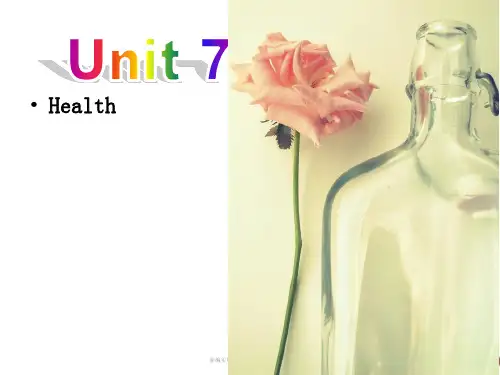
Book One Unit SevenNew Words and Expressions in Text A:1.trunk: n. 汽车后部的行李箱(n. 干线, 树干, 躯干, 箱子, 主干, 象鼻)2.struggle with/against: have difficulty handling or coping with 费力地对付; 和…斗争---Billy was struggling with a boy twice his size.---She struggled with the math problem but eventually worked it out.---We found the Smiths struggling with their car stuck in the mud.---struggle with illness/one’s conscience/economic problemsstruggle for:为…而斗争/搏斗---The poor had to struggle for a living.---I struggled with him for the knife.---He’s struggling for bigger say in decision-making/3.grocery: n. (usu. pl) 食品杂货》》》》grocer: n. shopkeeper who sells food in packets, tins, or bottles, and general small household requirements 杂货商4.locomotive: n. 机车5.horn: n. 喇叭6.nearby: I) a. not far away附近的---This drug can be bought at your nearby drugstore.---We stopped at some nearby shops to pick up some food.II) ad. in the area close by在附近---Jack found a part-time job in the company nearby.---All the towns nearby were crowded with tourists during the holiday.---The man spoke softly to an old lady standing nearby.7.thumbs-up: n. 翘拇指(赞同或满意的表示)a thumbs-up gesture: This is a sign that you make by making a fist and raising your thumb toshow that you agree with someone, that you are happy with an idea or situation, or that everything is all right.8.gesture: n. (c) movement of the hand or head to indicate or illustrate an idea, feeling, etc; sth.done to convey a friendly intention手势;姿势---make a friendly gesture to sb. 向…某人做友善的表示---gesture language手势语---a warlike gesture耀武扬威, 挑衅的姿态9.echo:I) v. 1) repeat (another’s words, ideas, etc.) 重复(别人说的话), 随声附和---They echoed every word of their leader.2) (+ back) (of places) send back an echo (指地方)发出回声; 共鸣(of sounds) be sent back as an echo (指声音)被传回---The room echoed with the sound of music/laughter.屋内音乐之声回荡/房间里充满了欢笑。
Unit 7 (1)Celebrating Holidays and Making Friends Teaching purposes:1. Ss learn to talk about giving and going to parties, get-togethers, reunions, etc.2. Ss learn and practice how to discuss arrangements and preparations for social activities.3. Ss learn how to invite and come to see exhibitions and shows.4. Ss master the use of comparatives of adjectives and adverbs.5. Ss should know about the way Christmas is celebrated around the world and traditional customs by which the Chinese celebrate holidays. Teaching procedures:I. Talking Face to FaceII. Being All EarsIII. Grammar ReviewIV. AssignmentI. Talking Face to FaceThe topic area of Talking Face to Face in this unit is to inform and talk about posts for celebrating holidays. The focus of functions therefore is on the patterns that are appropriate for giving information concerning announcements and posts for different holidays, social activities and recreations.Step 1: listen to the samples on page 86 with reference to the notices on page 85 and pick up some students to act out.Step 2: Ask students to recall some patterns and expressions for talking about recreational activities. And also give them some more as references. Reference:No admission fee is required for members of the club.Children under 6 are not permitted for admission.Admission is not permitted for children under 6.Casual dress is not accepted in the theatre.For booking, please stop at the Union club.There are still tickets available for the night shows.A choral concert will be given at the Municipal Arts Center.This Weeks Film: Tiny TimesIn case of rain, the runway show will take place in the gym.Buses are available and leave at 6:00 p.m. from the Days Hotel.Here comes a rare chance to appreciate the trio Tenors!The super star Super Junior will lead the performance.Step 3: Make dialogues according to the examples on page 87 and act out. II. Being All Ears1.Listen to Dialogue 1 and decode the message by finding the correctchoices in the blanks.2.Listen to Dialogue 2 and complete the statements.3.Listen to the dialogue again and do the multiple choice exercise.4.Do some listening exercises about PRECTOIII. Grammar1.“as+adj/adv+as或not so(as)+adj/adv+as.”句型。
该句型常用来描述两个比较对象的程度上的相似或不同(即平时说的“等级比较和不等级比较”)。
例如: My computer is not so(as) expensive as yours.我的电脑不如你的贵重。
2.“as many/few+可数名词复数+as”或“as much/little(少的)+不可数名词+as”。
前者描述数目上的接近, 后者描述量的相近。
例如: You may borrow as many books as you can.你能借多少书就借多少。
“Drink as much water as you can.” the doctor said to him.医生对他说到:“你要尽可能的多喝些水。
” 3.“主语+比较级+than any other…”结构表示:主语所描述的事物比其他任何一个都……比较级形式表示最高级含义。
例如: Li Ming is much cleverer than any other student in their class.李明是他们班中最聪明的学生。
注意:若比较范围不同, than后应用“any+可数名词的复数形式+其他”。
例如: China is larger that any countries in Africa.中国比非洲上的任何国家都大。
4.诸如not, never之类的否定词与形容词或副词的比较级连用, 表示最高级含义。
意为:再没有比…更…的了。
例如: It is not a better idea.这是再好不过的一个办法了。
I have never heard such an interesting story.我从来没有听过比这更有趣的故事了。
5.“形容词+to”结构也可表示比较含义。
例如: This kind of car is superior in quality to that.这种汽车的质量比那一种好得多(superior to意为:优于;胜过。
) Li ping is three years senior to Liu Gang.李平比刘刚大三岁。
(senior to意为:年长于;资格老于;地位高于。
) 6.“no+比较级+than”结构表示对两个比较对象都进行否定(可由neither…nor…结构来改写)。
例如: I’m no more foolish than you.我们俩都不傻。
(相当于Neither I nor you is foolish.) 7.“not more+比较级+than”结构表示在程度上前者不如后者。
例如: This book is not more interesting than that one.这本书不如那本书有趣。
(相当于The book is less interesting than that one.) 8.“形容词比较级+than+形容词”, 意为:与其…倒不如…。
例如: Jack is much harder than clever.与其说杰克聪明, 倒不如说他学习用功。
9.would rather…than, prefer…to…, prefer to do…rather than…这三个句型表示“宁愿…而不愿…;喜欢…胜过…;宁愿做…而不愿做…”含义。
虽无比较级形式, 但表示比较级含义。
例如: She would rather die than give in.她宁死不屈。
He preferred to go out rather than stay home.他宁愿出去也不愿呆在家里。
10.“The+比较级…, the+比较级…”。
该结构意为“越…, 越…”。
例如: The more difficult the questions are, the less likely he is able to answer them.问题越难, 他回答出来的可能性就越小。
11.what有时也可以表示“比较”关系, 说明两种事物的相同或相似性。
what的该种用法常用于书面语, 用来加强修辞效果, 含有比喻含义, 相当于as, 意为“好比…;正如…;就像…一样”。
what的该类用法共有3种情况: (1)A is to B what C is to D Twelve is two what twenty-four is to four.十二比二就等于二十四比四。
(2)what C is to D, A is to B What food is to the body, a book is to the mind.书籍对于思想犹如食物对于身体。
(3)what C is to D, that A is to B What the gun is to a soldier, that the pen is to a writer.作家的笔犹如战士的枪。
[巩固练习]请选出符合题意的最佳选项。
1.How beautiful she sings! I have never heard____.A.the better voiceB. a good voiceC. the better voiceD. a better voice 2.----Wait until we get a satisfactory reply, will you?-----I couldn’t agree ______.The idea is great to me.A.muchB. moreC. worseD. at all 3.The____you study, the _____you’ll be in it.A.hard; interestedB. harder; interestingC. harder; more interestedD. hardest; more interested 4.As far as I am concerned, education is about learning and the more you lean, ____ A. the more for life are you equipped B.the more equipped for life you are C.the more life you are equipped for D.you are equipped the more for life 5.The patient isn’t out of danger. He is _____ than he was yesterday.A.no betterB. worstC. not worseD. not more 6.Liu Fang studies much better than ____ student in his class.A.anyB. any otherC. the otherD. other 7.This year the farmers have produced twice __ grain___ they did last year.(NMET95)A.As less; asB. fewer; thanC. as much; asD. as many; as 8.In recent years travel companies have succeeded in selling us the idea that the farther we go, ____A.our holiday will be betterB. our holiday will be betterC. the better our holiday will beD. the better will our holiday be 9.---Are you satisfied with his answer? ---Not at all. It couldn’t have been___.A.Any betterB. worseC. as goodD. bad 10. Is the novel similar ___ you?A.forB. atC. asD. to 11. Rather than ___ to see the film he would prefer ____ stayed at home.A.go; toB. to goC. went; toD. would go 12.---What was his performance like? ---Oh, it couldn’t have been_____A.much wonderfulB. more wonderfulC. less wonderfulD. the most wonderful 13. John plays football____, if not better than David.(NMET94)A.as wellB. as well asC. so wellD. so well as 14. Reading is ____ him is ____to his life.A.for; whatB. as; likeC. to; whatD. at; as 15. This room is ____ much larger than that one.A.noB. not aC. no aD. as KEY:1.D2.B3.C4.C5.A6.B7.C8.C9.B 10.D 11. A 12.B 13.B 14.C 15.AIV. Assignment1.Act out the dialogues on page 872.Review the grammar. ( exercise 4 on page 98)3.Preview Passage 1. ( Search for some information about commonlycelebrated holidays in the West )Unit7 (2)Thanksgiving Day and Christmas Teaching purposes:1. Ss learn the traditional Western and Chinese holidays and festivals.2. Ss learn the traditional customs by which the Chinese celebrate holidays. Teaching procedures:I.Check the dialoguesII.Learn language IIII.AssignmentI . Check the dialoguesII. Passage1: Thanksgiving Day and ChristmasI) Information related to the reading passagemonly Celebrated Holidays in the Westa.Carnival: early in the new year. The main content is tohold a parade, a party, and other joyful activities.b.Valentine’s Day: February 14, for lovers to express theirlove to each other.c.April Fool’s Day: the first day of April. People can makeand tell white jokes to one another.d.Easter: usually in early April. This is a religious festival.On the very Sunday morning, children are busy lookingfor the color eggs assumed to be given by the Easterrabbit.e.Independence Day: July 4. It began from 1776. Thecelebration activities are mainly made up of a parade andmaking patriotic speeches.f.Halloween: the evening of October 31. Dancing partiesare held with people wearing fancy masks.g.Boxing Day: the first weekday after Christmas. Presentsare given to those who deliver newspaper, milk or otherkinds of service to the family to express the thanks fortheir good service and help.2.Silent Night, Holy NightThe title of the song may be translated as “圣诞夜” or “平安夜”. It is a very sweet Christmas carol.3.Santa Claus:Patron saint of children. The legend first came fromHolland and was brought to the US by Dutch immigrants. InAmerica, Santa Claus is fat and jolly, with white hair andbeard, and rides in the sky in a reindeer-drawn sleigh,delivering gifts to children at Christmas Eve.II) Language points and sentence structure(1) important Words1.bless: v. 祈福, 有福气, 保佑eg: May God bless you.This country is blessed with mild climate and rich land.Bless me!I’m blessed if I know.2.survive: v. continue to live or exist, remain alive after, liveor exist longer than 幸免于;比……长命eg: Very few people in the area survived the earthquake.It’s difficult for these plans to survive the cold climate inthe north.( The old lady has survived all her children.)3.hunt: v. go after wild animals; look for, try to find打猎;寻觅, 设法找到eg: Nobody is allowed to hunt here.All the people are helping hunt for a missing child.These students are hunting for a part-time job at the market.4.observe: v. celebrate; obey 庆祝;遵守eg: Do they observe Thanksgiving Day in that country?We always observe birthdays at home.All drivers should observe traffic laws strictly.5.include: v. bring in, reckon, as part of the whole包括eg: This book includes 20 chapters.Her duties include putting the children to bed.6.express: v. 表述, 表达;说明eg: I find it very difficult for me to express how grateful Iam for your kindness.She expressed her determination in this letter.7.associate: v. join or connect, be often in the company of联系, 联络, 有关系eg: I don’t want to associate myself with that matter.Don’t associate with these dishonest persons.We always associate the Great Wall with China.8.maintain: v. continue to keep up, retain保持, 维护;保养,供养eg: Teachers should maintain close ties with the students.The workers are busy maintaining the roads beforewinter comes.How could the students maintain themselves only by doing part time jobs?(2) some difficult sentences1.(Para. 1) Thanksgiving Day on the fourth Thursday ofNovember is ……in the New World.Analysis: In this sentence, uniquely means “specifically, solely”.Which introduces a relative clause, modifying an Americanholiday, Thanksgiving Day in this case.Translation:每年11月的第四个星期四的感恩节是惟有美国才有的节日。